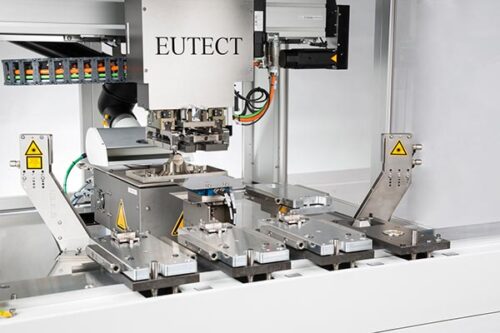 “There is no end to the requests for process optimization,” emphasizes Elmar Hölz, head of process development and optimization at the selective soldering specialist Eutect GmbH. “In some cases, we are approached by customers who have selected a new supplier for printed circuit boards, for example, after several years. This is partly necessary due to price developments, but is also based on market-related material and supply problems. However, after the change of supplier, the quality of the end product is often no longer right, which in most cases is due to changes in product properties and dimensions,” explains Hölz. In these cases, the process specialists of Eutect GmbH take over the adaptation of the parameters to the new production conditions. In some cases, this also applies to systems that do not originate from their company. “The need at electronics manufacturers is often great, especially when the order books are full,” says Lars Iwers, sales representative at Eutect GmbH.
“There is no end to the requests for process optimization,” emphasizes Elmar Hölz, head of process development and optimization at the selective soldering specialist Eutect GmbH. “In some cases, we are approached by customers who have selected a new supplier for printed circuit boards, for example, after several years. This is partly necessary due to price developments, but is also based on market-related material and supply problems. However, after the change of supplier, the quality of the end product is often no longer right, which in most cases is due to changes in product properties and dimensions,” explains Hölz. In these cases, the process specialists of Eutect GmbH take over the adaptation of the parameters to the new production conditions. In some cases, this also applies to systems that do not originate from their company. “The need at electronics manufacturers is often great, especially when the order books are full,” says Lars Iwers, sales representative at Eutect GmbH.
Some of these process optimizations are very complex. For example, Hölz recalls a production process in which a Hall sensor was to be soldered onto a circuit board. In addition to the different assembly variants, the different lengths of the circuit boards were also a challenge. Furthermore, the unpopulated PCBs were purchased from different suppliers. “As a result, each board suddenly had a different quality, which is why the soldering parameters had to be adjusted in each case,” recalls Hölz. Moreover, the process expert first had to find this out in a first step. After all, the origin of the quality problems was initially unclear.
Since soldering results of the same quality were to be achieved for all assemblies, new soldering parameters had to be determined for the different qualities of the boards provided by different suppliers. This resulted in the necessity to write and implement new soldering programs. Since the errors occurred as a result of different variants and qualities, a particularly high level of experience and know-how in soldering process technology was required here. As a result, the error rate was reduced from an average of 9% to 0-0.7% after Hölz adjusted the process parameters. “However, the boards originally used can still be soldered without any problems today without adjusting the parameters,” says Hölz.


